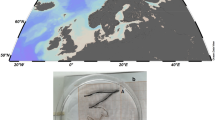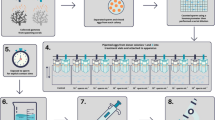Abstract
The timing of gamete release by fucoid algae, although known to be restricted to calm days is not clearly understood within a circadian time scale. The need for externally fertilizing species to avoid gamete dilution suggests that in wave-exposed areas spawning may occur during particular tidal phases. However, this may differ between mating systems, as selfing species may be less affected by gamete dilution. In this study, two different approaches were used to determine when egg release occurs during the tidal cycle in two sister species with different mating systems. First, egg settlement of Fucus vesiculosus (dioecious) and Fucus spiralis (selfing hermaphrodite) was quantified on removable substrates (egg settlement disks) every day for 2 months and settlement patterns were used to statistically estimate the radius of a circle that would encompass 99% of each patch of settled eggs (the egg dispersal radius). Also, egg release was quantified every 2 h during the tidal cycle. A significantly larger egg dispersal radius (P < 0.02) was found for F. spiralis than F. vesiculosus, and this difference was somewhat site dependent with a greater difference between species in exposed sites. The egg dispersal radius was negatively correlated with significant wave height and positively correlated with sea surface temperature for both the species (P < 0.05), with a greater effect of both the factors for F. spiralis than for F. vesiculosus. Egg release during the tidal cycle was variable between species and experiments, with F. vesiculosus releasing more eggs, later in the day, and at a lower tide, than F. spiralis, which released fewer eggs, throughout the day and at all tides. The dioecious species, F. vesiculosus, may have developed a specific adaptation for timing the egg release to periods when emersed in exposed habitats to avoid rapid dilution of gametes that require outcrossing for fertilization. On the other hand, egg release for F. spiralis, which can self-fertilize, occurred both when emersed and immersed, suggesting this species has developed less synchrony with specific environmental factors. Site dependence also suggests local wave conditions can modulate timing of release. The data are consistent with the relaxation of the selective constraints of water motion on fertilization success in a selfing hermaphrodite, relative to an obligate outcrossing species. Results support the idea that species with different mating systems evolve different sensitivities to environmental cues for gamete release with specific implications for inbreeding and successful external fertilization in the ocean.






Similar content being viewed by others
References
Belorustseva SA, Marfenin NN (2002) Affect of variable phases of tide cycle on reproduction of Laomedea flexuosa (Hydroidea, Thecaphora). Zh Obshch Biol 63(1):50–61
Berndt ML, Callow JA, Brawley SH (2002) Gamete concentrations and timing and success of fertilization in a rocky shore seaweed. Mar Ecol Prog Ser 226:273–285. doi:10.3354/meps226273
Billard E, Serrão EA, Pearson GA, Engel CR, Destombe C, Valero M (2005) Analysis of sexual phenotype and prezygotic fertility in natural populations of Fucus spiralis, F. vesiculosus (Fucaceae, Phaeophyceae) and their putative hybrids. Eur J Phycol 40:397–407
Brawley SH (1992) Fertilization in natural populations of the dioecious brown alga Fucus ceranoides and the importance of the polyspermy block. Mar Biol (Berl) 113:145–157. doi:10.1007/BF00367648
Brawley SH, Johnson LE, Pearson GA, Speransky V, Li R, Serrão E (1999) Gamete release at low tide in fucoid algae: maladaptive or advantageous? Am Zool 39(2):218–229
Coleman MA, Brawley SH (2005a) Are life history characteristics good predictors of genetic diversity and structure? A case study of the intertidal alga Fucus spiralis (Heterokontophyta; Phaeophyceae). J Phycol 41(4):753–762. doi:10.1111/j.0022-3646.2005.04136.x
Coleman MA, Brawley SH (2005b) Spatial and temporal variability in dispersal and population genetic structure of a rockpool alga. Mar Ecol Prog Ser 300:63–77. doi:10.3354/meps300063
Denny MW, Shibata MF (1989) Consequences of surf-zone turbulence for settlement and external fertilization. Am Nat 134:859–889. doi:10.1086/285018
Engel CR, Daguin C, Serrão EA (2005) Genetic entities and mating system in hermaphroditic Fucus spiralis and its close dioecious relative F. vesiculosus (Fucaceae, Phaeophyceae). Mol Ecol 14:2033–2046. doi:10.1111/j.1365-294X.2005.02558.x
Jaffe LF (1954) Stimulation of the discharge of gametangia from a brown alga by a change from light to darkness. Nature 174:743. doi:10.1038/174743a0
Kawamitsu Y, Boyer JS (1999) Photosynthesis and carbon storage between tides in a brown alga, Fucus vesiculosus. Mar Biol (Berl) 133:361–369. doi:10.1007/s002270050475
Ladah LB, Bermudez R, Pearson GA, Serrão EA (2003) Fertilization success and recruitment of dioecious and hermaphroditic fucoid seaweeds with contrasting distributions near their southern limit. Mar Ecol Prog Ser 262:173–183. doi:10.3354/meps262173
Levitan DR, Petersen C (1995) Sperm limitation in the sea. Trends Ecol Evol 10(6):228–231. doi:10.1016/S0169-5347(00)89071-0
Levitan DR, Sewell MA, Chia FS (1992) How distribution and abundance influence fertilization success in the sea urchin Strongylocentrotus franciscanus. Ecology 73:248–254. doi:10.2307/1938736
Marshall DJ, Semmens D, Cook C (2004) Consequences of spawning at low tide: limited gamete dispersal for a rockpool anemone. Mar Ecol Prog Ser 266:135–142. doi:10.3354/meps266135
Pearson GA, Brawley SH (1996) Reproductive ecology of Fucus distichus (Phaeophyceae): an intertidal alga with successful external fertilization. Mar Ecol Prog Ser 143:211–223. doi:10.3354/meps143211
Pearson GA, Brawley SH (1998) A model for signal transduction during gamete release in the fucoid alga Pelvetia compressa. Plant Physiol 118:305–313. doi:10.1104/pp.118.1.305
Pearson GA, Serrão EA (2006) Revisiting synchronous gamete release by fucoid algae in the intertidal zone: fertilization success and beyond? Integr Comp Biol 46(5):587–597. doi:10.1093/icb/icl030
Pearson GA, Serrão EA, Brawley SH (1998) Control of gamete release in fucoid algae: sensing hydrodynamic conditions via carbon acquisition. Ecology 79:1725–1739
Pearson GA, Serrão EA, Dring MJ, Schmid R (2004) Blue- and green-light signals for gamete release in the brown alga, Silvetia compressa. Oecologia 138:193–201. doi:10.1007/s00442-003-1424-z
Pennington JT (1985) The ecology of fertilization of echinoid eggs: the consequences of sperm dilution, adult aggregation, and synchronous spawning. Biol Bull 169:417–430. doi:10.2307/1541492
Perrin C, Daguin C, Van de Vliet M, Engel C, Pearson GA, Serrão EA (2007) Implications of mating system for genetic diversity of sister algal species: Fucus spiralis and Fucus vesiculosus (Heterokontophyta, Phaeophyceae). Eur J Phycol 42:219–230. doi:10.1080/09670260701336554
Santelices B (2002) Recent advances in fertilization ecology of macroalgae. J Phycol 38(1):4–10. doi:10.1046/j.1529-8817.2002.00193.x
Serrão EA, Pearson G, Kautsky L, Brawley SH (1996) Successful external fertilization in turbulent environments. Proc Natl Acad Sci USA 93(11):5286–5290. doi:10.1073/pnas.93.11.5286
Thompson TL, Glenn EP (1994) Plaster standards to measure water motion. Limnol Oceanogr 39(7):1768–1779
Togashi T, Cox P (2001) Tidal-linked synchrony of gamete release in the marine green alga, Monostroma angicava Kjellman. J Exp Mar Biol Ecol 264(2):117–131
Yund PO (2000) How severe is sperm limitation in natural populations of marine free-spawners? Trends Ecol Evol 15:10–13. doi:10.1016/S0169-5347(99)01744-9
Acknowledgments
The authors are very thankful to the marine laboratory of Universidade de Évora for hosting us in Sines (especially to Teresa and João Cruz), and to Rafael Bermudez for technical help. We thank anonymous referees for their helpful suggestions. This study was funded by the Portuguese Science Foundation (FCT), including programs POCTI, POCI with FEDER and ESF. Funding to LBL was provided by CONACYT and UC MEXUS. Funding to FF was provided by NSF and CA Sea Grant.
Author information
Authors and Affiliations
Corresponding author
Additional information
Communicated by S.D. Connell.
Rights and permissions
About this article
Cite this article
Ladah, L.B., Feddersen, F., Pearson, G.A. et al. Egg release and settlement patterns of dioecious and hermaphroditic fucoid algae during the tidal cycle. Mar Biol 155, 583–591 (2008). https://doi.org/10.1007/s00227-008-1054-4
Received:
Accepted:
Published:
Issue Date:
DOI: https://doi.org/10.1007/s00227-008-1054-4




